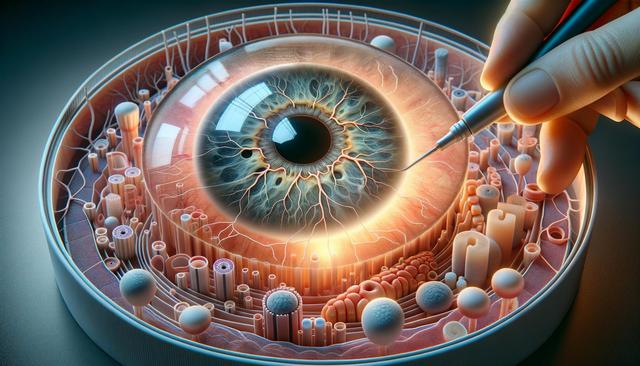What Is Macular Degeneration?
Macular degeneration, often referred to as age-related macular degeneration (AMD), is a progressive eye condition that primarily affects individuals over the age of 50. It targets the macula, a small but critical part of the retina responsible for sharp central vision. The loss of central vision can make routine activities, such as reading, driving, or recognizing faces, increasingly difficult. As part of the broader topic of “Understanding Macular Degeneration: A Closer Look at Eye Health,” it’s important to understand that this condition does not typically lead to complete blindness, but the deterioration of central vision can significantly impact quality of life.
There are two primary types of macular degeneration: dry and wet. Dry macular degeneration is the more common form, characterized by the thinning of the macula and gradual loss of vision. Wet macular degeneration, though less common, is more severe and progresses faster due to abnormal blood vessels leaking fluid or blood into the retina. Recognizing the early symptoms of either type can be crucial for timely intervention.
Causes and Risk Factors
Understanding the potential causes and risk factors associated with macular degeneration is key to both prevention and early detection. While age remains the most significant risk factor, several other elements can contribute to the development of this condition. Genetics also play a role, as individuals with a family history of AMD are at increased risk. Environmental and lifestyle factors further influence the likelihood of developing macular degeneration.
Common risk factors include:
- Smoking, which significantly increases the risk of AMD
- Obesity and poor diet, especially diets lacking in antioxidants
- High blood pressure and cardiovascular disease
- Excessive exposure to ultraviolet (UV) light
- Light eye color, which may provide less natural protection against UV rays
Incorporating these risk elements into the broader conversation of “Understanding Macular Degeneration: A Closer Look at Eye Health” helps emphasize the importance of lifestyle modifications and regular eye exams in reducing the risk of vision loss.
Recognizing the Symptoms
Early detection of macular degeneration can make a notable difference in managing the condition. Initial signs are often subtle, making routine eye check-ups essential. One of the most common early symptoms is blurry or distorted central vision. Straight lines may appear wavy, or objects may seem smaller or farther away than they are. As the disease progresses, these visual impairments become more pronounced and can interfere with everyday tasks.
Key symptoms to watch for include:
- Difficulty seeing in low light or adjusting to changes in lighting
- A blurred or blind spot in the center of your vision
- Decreased brightness or intensity of colors
- Visual distortions, such as lines appearing bent
By being vigilant about these signs and incorporating them into a personal plan for “Understanding Macular Degeneration: A Closer Look at Eye Health,” individuals can take proactive steps to preserve their vision and seek medical advice when necessary.
Diagnosis and Treatment Options
Diagnosing macular degeneration typically begins with a comprehensive eye exam. Eye care professionals may use tools such as the Amsler grid to detect vision distortions and imaging tests like optical coherence tomography (OCT) to view cross-sections of the retina. Anti-VEGF injections are a common treatment for wet macular degeneration, helping to stop the growth of abnormal blood vessels and reduce fluid leakage.
Other treatment options and management strategies include:
- High-dose vitamin and mineral supplements (AREDS2 formulation)
- Low vision aids such as magnifying glasses or specialized lighting
- Laser therapy in some cases of wet AMD
- Lifestyle changes to improve overall eye health
Although there is no cure for macular degeneration, early diagnosis and a tailored treatment plan can slow its progression. These treatment approaches tie directly into “Understanding Macular Degeneration: A Closer Look at Eye Health,” emphasizing the importance of ongoing care and monitoring.
Living with Macular Degeneration
Adapting to life with macular degeneration involves both emotional and practical adjustments. While the loss of central vision can present challenges, many individuals continue to lead fulfilling lives with the support of assistive technologies and rehabilitation services. Vision rehabilitation programs can teach adaptive techniques to maintain independence, and support groups provide valuable emotional reinforcement.
Practical tips for daily life with macular degeneration include:
- Using high-contrast, large-print materials
- Organizing home environments to minimize hazards
- Utilizing voice-activated and screen-reading technologies
- Regularly visiting an eye care specialist for monitoring
Focusing on mental well-being is also crucial. Depression and anxiety are not uncommon, given the impact on daily routines. Integrating mental health resources into a care plan can help manage these emotional challenges. In the broader context of “Understanding Macular Degeneration: A Closer Look at Eye Health,” these strategies highlight how comprehensive care can improve overall quality of life.
Conclusion: Prioritizing Long-Term Eye Health
Macular degeneration is a condition that underscores the importance of proactive and informed eye care, especially as we age. By understanding the risk factors, recognizing symptoms early, and exploring available treatments, individuals can take meaningful steps toward preserving their vision. Regular eye exams, a healthy lifestyle, and access to appropriate medical care all play vital roles in managing this condition.
For anyone navigating the challenges of macular degeneration, knowledge truly is power. With the right information and support, it’s possible to adapt and maintain a high quality of life. As highlighted throughout this guide on “Understanding Macular Degeneration: A Closer Look at Eye Health,” a deeper awareness can empower individuals and their families to make informed decisions for long-term eye wellness.




Leave a Reply